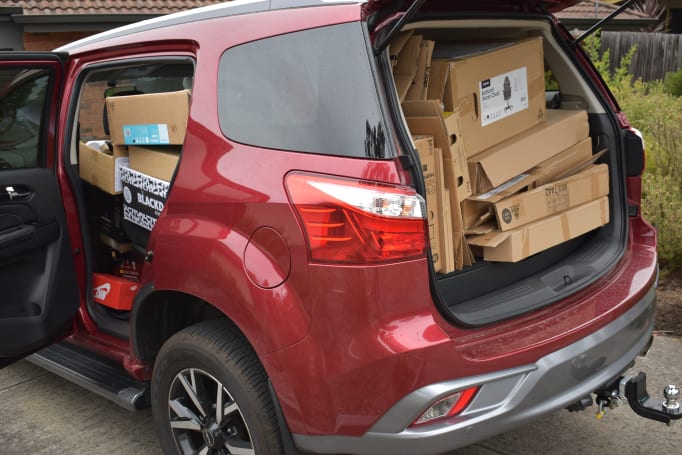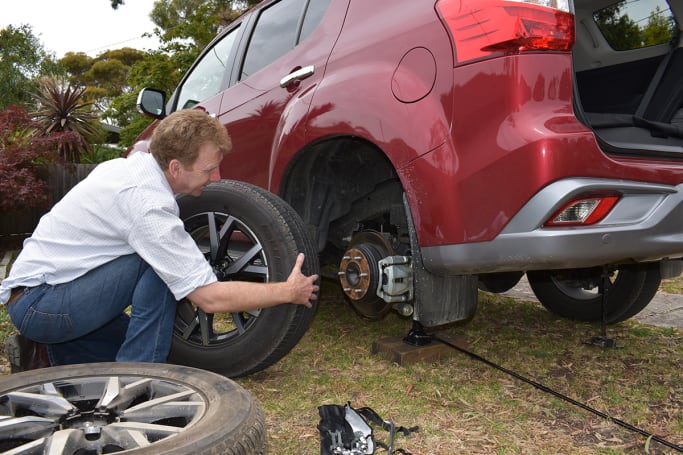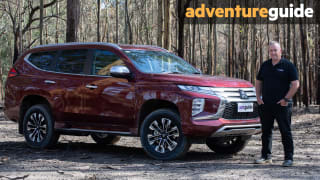I love reading stats. To some they may seem as dry as a packet of Weetbix but in these days of increasing public scepticism about the accuracy of information published online, there's something reassuring about hard, indisputable stats produced by trusted sources.
A good example is the VFACTS report issued each month by the Federal Chamber of Automotive Industries or FCAI. A dozen times a year it provides the automotive industry with sales figures for all new vehicles in Australia. It's a brutally accurate snapshot of how the industry and its many players are performing, broken down into numerous segments showing the makes and models which compete in each.
One of the most competitive of those, with almost 30 contenders, is for large SUVs under $70,000. It's long been dominated by Toyota's Prado and Kluger twins, but the numbers that consistently jump off the page for me belong to the third best-seller – Isuzu's MU-X.
Sheez, talk about a quiet achiever. Holding just under 8.0 per cent of this hotly-contested segment up to and including November 2019, Isuzu's venerable SUV comfortably outsells perpetual favourites including the Mazda CX-9, Subaru Outback and Hyundai Santa Fe to name a few.

And given that it's derived from Isuzu's D-MAX ute, it also comfortably outsells all other high-riding body-on-frame SUVs sharing similar utilitarian parentage. With annual sales of 7616 units so far, the MU-X attracts more showroom traffic than the ute-derived Mitsubishi Pajero Sport (6073), Ford Everest (4892), Toyota Fortuner (2808) and Holden's distant relative Trailblazer (2596).
Excuse me for indulging in one of my favourite pastimes (yeah, I need to get out more) but those VFACTS figures don't lie. Isuzu Ute Australia's MU-X seven-seater is consistently kicking the backsides of some good players with a vehicle which, apart from relatively minor mechanical, exterior and interior revisions along the way, is effectively the same as that launched here in late 2013.
So when the good people at Isuzu Ute Australia offered CarsGuide the keys to a 2019 MU-X in premium LS-T grade for an extended three-month review, I put my hand up because I've long mused over the MU-X's enduring popularity. By making it the honorary member of a busy family with two teenage kids over a longer time-frame, its strengths and weaknesses in this 'real world' role can be more meaningfully assessed.
So why is it such a strong seller? For a start it's competitively priced. Our Magnetic Red LS-T test vehicle has a recommended retail price starting at $56,400, which compares well with its ute-based premium-grade rivals including the Holden Trailblazer Z71 ($53,490), Mitsubishi Pajero Sport Exceed ($54,490), Toyota Fortuner Crusade B+R Trim ($58,490) and the considerably more expensive Ford Everest Titanium ($73,990). However, IUA tells us that razor-sharp drive-away deals can be as low as $54,490.
Another reason is its enviable reputation as a competent all-rounder, with reliability and build quality on its side. There's definitely a peace-of-mind factor at work here, that comes with owning a vehicle that's been designed and built by one of the world's leading commercial truck manufacturers.
The MU-X has been rarely mentioned in factory recalls since its launch in 2013 and those items were non-mechanical and only minor in nature, so buyers must feel comfortable when parting with their hard-earned dollars here. The six years/150,000km warranty with six years roadside assist and capped-price servicing shows plenty of confidence by Isuzu in the product too.

It adheres to a design blueprint shared by all of its ute-based SUVs rivals. They're all body-on-frame with shorter wheelbases and lengths than the utes on which they're based. And they all have coil-spring rear suspensions in preference to their parents' harsher-riding leaf springs.
However, at 3.0 litres in cubic capacity (130kW/430Nm) the MU-X has the largest turbo-diesel of them all which is highly prized, particularly by those who need to tow up to its 3000kg braked towing capacity. Combined with a sweet-shifting and intelligent Aisin six-speed torque converter automatic, part-time dual-range 4x4, four-wheel disc brakes and speed-sensitive power-assisted steering, it's a well-engineered and proven package.
There's nice external detailing with plenty of chrome and colour-coded highlights. The LS-T interior also appeals with its plush leather-appointed trim and thick carpets which are comfortable and easy to keep clean. It's also equipped with most of the usual bling we associate with premium-grade models, highlighted by an overhead fold-down 10-inch DVD screen with remote control for movie-goers seated in the back stalls.
However, it does miss out on numerous features found in some of its rivals like 'active' cruise control, dual-zone (rather than single) climate control, Apple CarPlay/Android Auto and DAB+ digital radio, steering wheel reach adjustment, rear diff lock, heated front seats, power-adjustable front passenger seat and power tailgate to name a few.
The MU-X wears a five-star ANCAP badge (albeit from its first and only test in 2013) but also misses out on useful safety tech found in some of its peers like AEB and lane-keeping assist.
So, when comparing spec sheets, the MU-X looks a bit light-on for luxury appointments and the latest safety features. However, its kick-arse sales suggest that what it does have is more than enough, for both Isuzu loyalists and newcomers to the brand. Bottom line is, whatever Isuzu is doing, it's working!
When we collected the MU-X LS-T in Melbourne it had 3733km on the odometer and in our first month of ownership we've added 1430km. Isuzu claims an official combined figure of 7.9L/100km, which compares to the dash readout's 9.3L average. Our own figures based on fuel bowser and trip meter readings varied between 10.6 and 10.9L/100km. Yes, that's higher again, but still respectable given it was achieved during mostly suburban driving including morning and afternoon school runs, party drop-offs, weekly grocery shopping and a weekend run to the tip.
In this typical suburban family car role, the MU-X is practical and easy to live with. The third row of seats is ideal for primary school-sized kids but, like all seven-seat SUVs, becomes increasingly squeezy for rapidly-growing teenagers. It's okay for short runs but on longer trips you'll get complaints.
Two rows of folding seats are also useful in being able to adjust load areas to suit different tasks. For example, if you leave the third-row upright it leaves a compact space behind it that's ideal for snug containment of small shopping loads. Folding the third-row flat opens up ample space for larger shopping trips, or for carting around the family pooch.
If you need even more space, the second row can be folded flat to extend the load floor to the front seats or tumbled forward if more load volume is required. We've already found this particularly useful on two occasions; one was swallowing a large IKEA cabinet in DIY flat-pack form and the other was filling it with cardboard to offload at the local recycling centre. It can also easily accommodate an adult-sized mountain bike lying on its side.
Good news for potential family buyers too is that the MU-X appeals to both mum and dad drivers. It might be a high-riding off-roader but my 168cm-tall wife is a fan, praising its commanding view from the driver's seat, ease of entry/exit with the side-steps and truck-like solidity that makes her feel safe. Happy wife, happy life.
She also likes the large windows and mirrors, front/rear parking sensors and large crystal-clear view provided by the reversing camera, which make regular suburban chores like shopping centre parking remarkably stress-free. She also says it's easy to load.
Under-the-bonnet maintenance items like the engine oil dipstick, windscreen washer bottle etc are easy to access. I also put the standard wheel-changing equipment through its paces to see how it might perform if we're unlucky enough to need it in a remote area with patchy phone coverage.
It's always best to familiarise yourself with this process at home, rather than be trying to figure it out for the first time on a dark, rainy night with no torch. It was a fiddly process, but it did the job as instructed. However, not included in the standard tool kit is a block of hardwood for jacking, a pair of overalls to keep clean and a torch, which we'd also recommend.
So the first month of MU-X ownership has already provided a clearer understanding of why this vehicle is such a popular choice for Aussie buyers. Next month we're travelling further afield to provide insights on how it performs away from the big smoke.
Acquired: December 2019
Distance travelled this month: 1430km
Odometer: 5163km
Average fuel consumption for December: 10.6 to 10.9L/100km (measured at the pump)
































